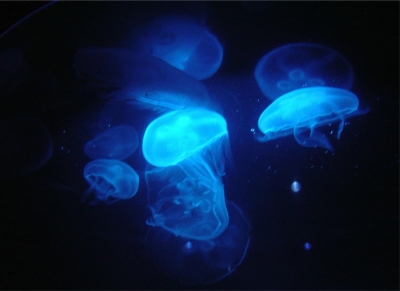The world's largest glowing vertebrate turned out to be a 'luminous deep-sea shark,' and why did giant sharks bother to glow?

by Mallefet et al., Front. Mar. Sci., 2021
It is known that sea creatures often emit light from their bodies by
Frontiers | Bioluminescence of the Largest Luminous Vertebrate, the Kitefin Shark, Dalatias licha: First Insights and Comparative Aspects | Marine Science
https://www.frontiersin.org/articles/10.3389/fmars.2021.633582/full
We Just Found The Largest Luminous Glowing Shark Species in The World
https://www.sciencealert.com/three-new-luminous-glowing-sharks-have-been-found-living-in-the-ocean-s-dark-depths
Glow-in-the-dark sharks captured on camera for first time ever
https://www.9news.com.au/national/glow-in-the-dark-shark-photographed-producing-own-light-in-world-first-by-scientists/4c441d3d-a427-4753-bf58- 9e73eb1ab277
Jerome Mallefet, an oceanographer at the University of Louvain Catholic in Belgium, has been working on a variety of sharks to investigate kitefin sharks , wisteria whales, and splinter crows, whose existence has been confirmed for a long time but whose ecology remains a mystery. Get a shark specimen. By taking pictures and dissecting in the dark, we confirmed how the body surface was emitting light and whether or not there was a photophore.
As a result, it was found that all three species of sharks have organs that emit light on their body surfaces. The following is a photograph of the side (top) and back (bottom) of the Kitefin shark in bright and dark places. Not only the surface of the body but also a part of the dorsal fin (red arrow) is shining.

by Mallefet et al., Front. Mar. Sci., 2021
Of the three species of sharks that have been identified to bioluminescent this time, the largest is the kitefin shark, which is known to grow up to a total length of 180 cm. For this reason, Mallefet et al. Positioned the kitefin shark as 'the largest known vertebrate known to emit light.'
In addition, the following is a photograph of the light emission pattern of Fuji whale. In the wisteria whale, it was observed that the photophore was concentrated especially on the ventral side.

by Mallefet et al., Front. Mar. Sci., 2021
Kitefin sharks, wisteria whales, and thorny crow sharks are all sharks that live in an area called the 'twilight zone' at a depth of 200 to 1000 m. Very weak sunlight shines into the ocean at this depth, so when you look in the direction of the sea surface from a deeper area, the silhouette of swimming creatures becomes clear.
Therefore, scientists speculate that 'sharks may be hiding themselves and sneaking up on their prey using counter-illuminations that glow themselves and melt their bodies into the dim light.' However, the research team concluded that further investigation was needed because the counter-illumination alone could not explain the fact that it shines up to the dorsal fin like a kitefin shark.
In making this discovery, which identified the world's largest glowing vertebrate, Mallefet said, 'My goal is to learn more about the world's most expansive yet mysterious deep sea and to conserve its environment. To let people know about it. '
Related Posts:







